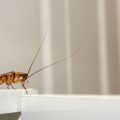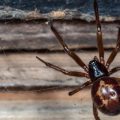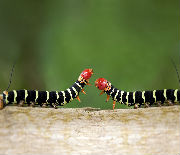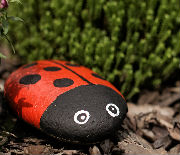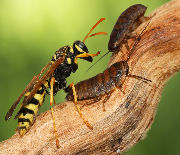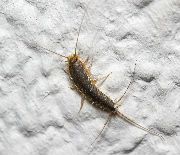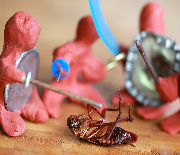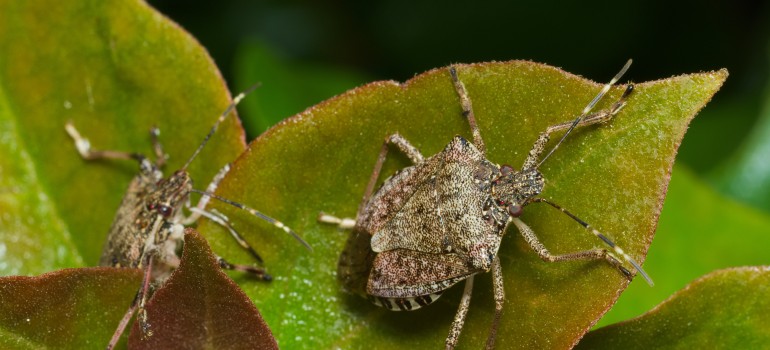
The brown shield bug (Halyomorpha halys) has become a notable pest in the UK, threatening various plants and crops. A stink bug, or shield bug, releases a foul-smelling liquid to deter predators. The foul-smelling brown shield bug is named after its scent glands.
These cause it to emit an unpleasant odour when threatened or injured, which is how the pest earned its name. Their pheromones are strong, and the smell lingers in the air for quite some time. Keep that in mind if you decide to squash a stink bug.
During the cold months, most types of stink bugs seek shelter indoors and around the exterior of buildings. They may crawl into cracks or crevices, under the peeling bark of old trees, or in other hiding places, such as our cosy home. Without a doubt, a cluster of bugs hibernating in the corner of window frames or curtain pelmets can produce an unpleasant and persistent smell.
In this helpful article, we have gathered all the information you need to deal with these stinky beasties.
Table of Contents
Identifying the brown shield bug in the UK
The brown marmorated stink bug is shield-shaped and approximately 17 mm (5/8 inch) long during adulthood. These shield bugs have pale dots across the edges of their scutellum, with an almost rectangular head and light-toned bands on their antennae. They look very similar to the Hairy Shield Bug, which has three whitish bands on its antennae, while the BMSB has only two.
The brown shield bug, commonly known as the “stink bug,” is a sap-feeding insect that can damage crops by sucking out plant fluids. Originally from Asia, it has recently expanded its range to the UK due to warmer climates and global trade. The adult stink bug is about 2 cm long and wide.
Stink bugs reproduce rapidly, have a relatively long lifespan (six to eight months), and can even fly. When on the ground, the stink bug’s wings fold up on its back, giving it a shield-like appearance. However, when in flight, these strong wings allow the bug to take advantage of wind currents and travel farther. It is easy to identify adult stink bugs, as they have fully developed wings.
Do shield bugs bite in the UK?
Are shield bugs harmful? Luckily, the brown marmorated stink bug doesn’t sting or bite. They emit a pungent odour as their only means of defence. If you see a single stink bug, don’t crush it; it will emit a strong smell that may attract other pests. They’re not designed to pierce, sting, or bite through human skin, so there’s no real reason to squish it.
Stink bugs, or brown shield bugs, are not usually dangerous to humans or pets. However, they can pose a threat to agriculture and be a nuisance.
Damage caused by the brown shield bug
While it’s native to China, Japan, and Korea, the brown marmorated stink bug has made it to the UK and can cause major agricultural damage. They can easily ravage crops, and since one bug can feed on many different plants, losses can be substantial.
These bugs can sometimes interfere with the winemaking process, and if they are not removed promptly, they can contaminate the wine. This often results in the entire wine harvest being thrown away. A huge waste of fresh, ripe grapes and a loss of profit.
If you have a bunch of grapes that contain stink bugs and you grind them up into wine, the bugs’ smell gets into the drink and makes consumers unhappy. Their scent leaves a noticeable odour in wine, often described by people as “an unpleasant, almond-like smell”.
Adults and nymphs inject enzymes that can damage plant tissue and suck juices from fruit crops. The bug may harm fruits and vegetables during the summer, and, like other pests, can move indoors during the winter.
They don’t reproduce indoors, nor do they feed on wood, therefore, they cannot cause structural damage to buildings. But that doesn’t mean they’re not annoying.
Check also: Where Do Insects Go in the Winter Time?
What do stink bugs eat?
In the summer, these pests feed on fruits and vegetables, such as apples, pears, peaches, tomatoes, and sweetcorn. When piercing the surface with their needle-like mouths and sucking out the fruit’s juice, they also inject a toxin into the fruit.
When they are done, they leave behind spots and blemishes that make the fruit inedible. In other words, these insects’ saliva is toxic to the fruit cells, so when the damaged fruit grows, it develops a scar.
Lifecycle and behaviour of the brown shield bug
The brown marmorated stink bug is a hemimetabolous insect that takes approximately 40 to 60 days to develop from egg to adult. Nymphs are nocturnal and complete five stages in a week. They are orange or orange-red and remain near the egg mass until they shed their outer layer.
The eggs of the brown marmorated stink bug are oval-shaped and green in colour. They are laid in masses that can be as many as 30 eggs and are often found under leaves and on the underside of the leaf. Egg-laying generally happens from May through August.
How to get rid of brown marmorated stink bugs
To combat a pest effectively, you have to familiarise yourself with them. Specifically, we will target insects that see your garden as an all-you-can-eat buffet.
You can use several methods to keep your crops healthy when faced with a plant-eating insect.
Effective ways to prevent the brown shield bug infestation
The best way to keep stink bugs out of your home is to block their path. Sealing cracks, gaps, and openings will help prevent these insects from entering your home. Not only will this help you avoid an invasion of stink bugs, but it also helps prevent their potential life cycle of re-infestation.
If the screens on your doors or windows are damaged or loose, they should be replaced immediately. Exterior doors that are not tight-fitting should be adjusted.
In addition, stink bugs are attracted to lights. They can often be seen flying around street lights at night and in large numbers. To prevent them from entering homes, it’s always a good idea to keep exterior lights off when entering or exiting your house.
One of the best methods to get rid of stink bugs and prevent infestations is simply vacuuming. With the help of a vacuum cleaner, you can physically remove them from walls and windows.
Check also: Pest Proofing Your Home
Home remedies to get rid of stink bugs
Can I remove brown shield bugs without chemicals? If you prefer using natural repellents to control stink bugs in your garden, you may also want to consider spraying them with a mineral clay solution to prevent the bugs from attaching to the plants and laying eggs. Manual removal and natural deterrents like neem oil are effective for small infestations.
In addition, you can use a mixture of water and lavender oil or olive oil to repel stink bugs. A regular spray bottle or garden sprayer is perfect for applying the mixture.
Making a homemade insecticide from vegetable oil and soap is another effective solution. Mix a cup of vegetable oil with one tablespoon of soap, and then add one quart of water. Shake thoroughly and spray directly on the affected plants.
Besides being biodegradable and nontoxic to pets, birds, fish, and other wildlife, neem oil has been found effective against common garden pests, and it can also protect plants from powdery mildew and other fungi. Many garden and food stores sell neem oil, so you can either follow the instructions on the bottle or start with a simple mix of two teaspoons of the oil, one teaspoon of liquid soap, and a quart of water.
Check also: Humane Methods for Handling Common Household Pests
Insecticide concentrates for stink bugs
Sometimes, after all your efforts have failed, all you have left is the use of pesticides. Stink bugs are highly resistant to most pesticides, so their removal can be a challenge. They have a waxy coating that prevents poisons from penetrating. However, there are a few options you can try. Rotenone, Insecticidal soap, and a few others can be used to deter these smelly creatures.
Although insecticides may temporarily discourage stink bugs from entering homes, they only affect a small percentage of them. While insecticidal dust may kill bugs inside the walls, the carcasses can smell and attract other unwanted guests, such as carpet beetles. These pests will damage other things in your home.
Applying an interior pesticide most probably will not be efficient enough, and they will emerge from the baseboards after a few days. Hence, you may need to seek a professional team to help you get rid of stink bugs.
You can also prevent insects from entering your home by using insecticides around the garden. This method is effective for several days up to a week, depending on the quantity of insecticide applied.
Caution: You should read labels carefully and follow the directions when handling pesticides. Keep containers away from children, pets, and wildlife. Dispose of empty containers in a safe way and place.
Nothing is better than a professional service!
Benefit from a professional pest control service with commercial grade products, that is provided by experienced technicians!
Call usPrevent brown shield bugs in your garden
Brown shield bugs are attracted to various plants, especially those with high sap content, like fruit and vegetable crops. Stink bugs mainly feed on plants. Therefore, they’re a common garden pest and often invade orchards and residential landscapes during spring. As the temperatures rise, stink bugs emerge from hibernation. Females eventually begin to lay their eggs on nearby plants.
One of the first steps in eliminating stink bugs is to remove all nearby weeds or overgrowth that they use as cover, as well as any hiding places like old boards or logs. The garden and surrounding area should be kept clean and free of debris.
In case you are growing any type of vegetables in your garden, cover them with a row cover material or net. Such covers can prevent bugs from eating your crops. A light, permeable material, usually made of polypropylene or polyester, can be used to prevent damage by a wide variety of pests.
When you first see stink bugs on your plants, you should spray them directly with water. This will physically force the insects off the plants and break down their exoskeletons.
Natural predators of the brown shield bug
Above all, stink bugs UK have a large number of natural enemies. Encouraging natural predators is an environmentally friendly way to control brown shield bugs. Birds, parasitic wasps, and predatory insects, such as ladybirds, play a role in managing bug populations. Creating a habitat for these beneficial species, with a variety of plants and water sources, can naturally reduce bug numbers.
To sum up
It’s important to remember that killing all of the insects in your garden is not the goal here since any healthy ecosystem needs a lot of beneficial insects and microbes in the soil. A good pest management strategy includes introducing predatory insects like ladybugs and praying mantises.

